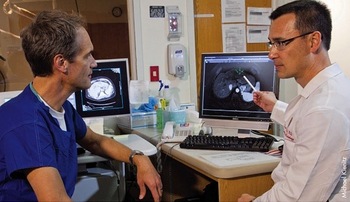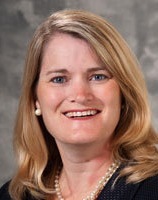Company developing radio frequency technology to localize breast tumors
Breast cancer may inspire more public discussion, advocacy and charitable giving than almost any other disease besides HIV and AIDS. But people rarely talk about the specific experiences to which cancer patients are subjected.
Especially the localization wire.
A localization wire literally is a thin wire inserted into the breast through a needle to help mark the location of a tumor or benign mass on the day of surgery. For the patient, it’s one more step in an already painful and emotionally agonizing process.
For a group of University of Wisconsin–Madison engineers and clinicians, it was an opportunity to develop a solution that is technologically elegant, precise and patient-centric.

Dan van der Weide (left) and Fred Lee
Photo: Michael Kienitz
The team’s solution — a system that replaces the localization wire with a radio-frequency tag that helps the surgeon track the tumor’s location with greater precision — was the impetus for the researchers to found the company Elucent Medical. The company’s proposal, which aims to benefit patients and care providers alike, recently won the 2014 Wisconsin Governor’s Business Plan Contest.
Dan van der Weide, a UW–Madison professor of electrical and computer engineering and one of Elucent’s founders, discusses the localization wire with palpable dismay. “It’s not something I think I would wish on anyone,” he says. “It’s stressful to place this wire on the day of a difficult surgery.”
And to an engineer’s eye, the localization wire creates all kinds of obstacles to the end goals of removing a tumor while preserving as much healthy breast tissue as possible. For example, the wire is inserted when the breast is compressed in a mammogram machine or under ultrasound guidance. If the mass or cancer is in the center of the breast, there may be a distance of more than two inches from that mass to the skin where the wire must exit.

Lee Wilke
“I get a 2-D picture of where the wire is in the breast, but it’s a 3-D event — and requires piecing the pictures together to find the cancer,” says Elucent’s Lee Wilke, director of the UW Health Breast Center and a UW–Madison professor of surgery.
Even at best, the localization wire is simply marking one point along the boundary of the tumor, leaving it to the surgeon to figure out the rest of the picture. “The wire can be very biased, because it only comes from one direction,” Wilke says. “It’s been this way for more than 30 years.”
One possible workaround is to implant a small radioactive pellet at the location of the tumor, then track it with a handheld radiation detector. But Wilke points out that cancer clinicians are already exposed to a lot of radiation, and putting them at even more risk obviously isn’t good for anyone.
Radio frequency identification (RFID), a widespread technology with many applications in tracking and communication, offers a compromise.
The solution depends on expanding the scope of a relatively simple technology with many everyday uses. A pet that’s been “microchipped” has been implanted with an integrated circuit that uses RFID technology to transmit identifying information when scanned. One of Elucent’s main technical challenges is to create a new kind of RFID tag that will better adapt the technology to localization purposes. “There’s no facility for saying, look, the tag is exactly 3.5 cm deep and over 1 cm from where your reader is,” van der Weide says.
Surgeons like Wilke would welcome a viable alternative to the localization wire, provided it is easy to learn and use.
He currently is working on designing a coil array that can wrap around an RFID tag and provide more precise location data via a wand-like reader in the operating room.
Elucent’s founding team draws on past successes with medical-engineering collaborations. Van der Weide, radiology Professor Fred Lee and Chris Brace, an associate professor of biomedical engineering and radiology, previously have worked together to advance technology for tumor ablation, founding the company NeuWave Medical in the process. Former NeuWave CEO Laura King now heads up Elucent, which also boasts Elizabeth Burnside, a UW–Madison associate professor of radiology and industrial and systems engineering.
Surgeons like Wilke would welcome a viable alternative to the localization wire, provided it is easy to learn and use, and van der Weide takes pride in the fact that Elucent’s solution to the problem isn’t really all that complex. In fact, the company’s big pitch is that it makes the treatment process cheaper and logistically simpler. Because the tag could be implanted while the patient undergoes a biopsy, it essentially would eliminate not only the wire but also the entire localization wire-implant procedure, which the company says can save up to $2,500 per patient.
Before Elucent can replace the localization wire with what’s essentially a small metal pellet, the engineers will refine the object’s design and seek regulatory approval. But the team is confident that stepping back and rethinking an outdated procedure will elevate the standards of care and dignity for breast cancer patients.
“A lot of medical procedures evolved out of an immediate need, and common sense and simplicity weren’t at the forefront,” van der Weide says.




